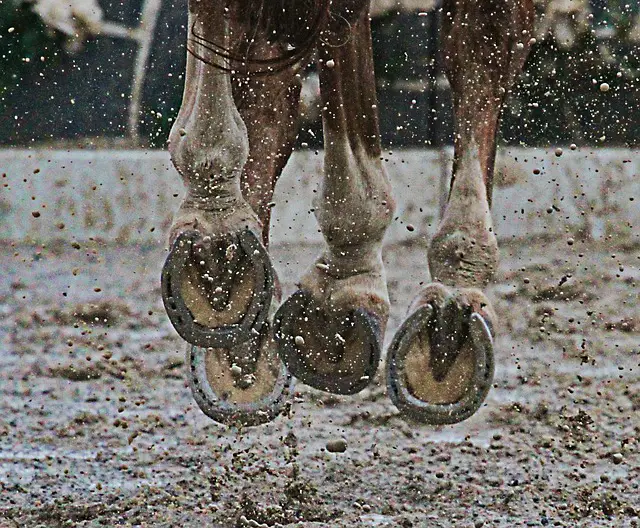Last Updated on March 11, 2022 by Allison Price
February 21, 2019, Pete Butler Categories: anatomy, horsefoot care, history of horseshoeing 0 comments Tags : Butler farrier schools and Butler horseshoeing school, basic farrier training, Butler Professional Farrier Schools, competency in horse care, DBE-Continuing Farrier Education. Equine foot care. Foot function. frog. hoof care. thrush
The horse’s frog is the wedge-shaped, insensitive cushion or pad. Its function is to provide shock absorption, blood circulation, and traction for the horse.
The foot of a horse is a bio-mechanical marvel that has many parts. Each part serves a specific purpose. The frog is one of the most fascinating parts. The horse’s frog is a wedge-shaped, insensitive cushion or pad that provides shock absorption, traction, and circulation. It also contains a scent gland.

Although it is not known how the frog got its name, there are many theories. Smith refers to this structure as a “footpad” in his Manual of Veterinary Physiology (1921), but admits that it is also “vulgarly recognized” as the “frog”.
Superstition is one of the most popular theories about how the frog got its name. Horsemen used to carry the bone from a frog (the amphibian) in their pockets as luck charms. The shape of the horse’s foot structure is reflected in the frog pelvis. Many believe it was a common term to refer to the hoof as a “frog” because horses’ feet, and horseshoes in particular, are believed to bring good luck. Although it’s not known when horsemen began to refer to the hoof structure in this way as a “frog”, it is clear that they look similar. Other theories state that the frog (hoof structure) is found under the hoof in the same way the amphibious frog might hide under a rock (Equus, August 1985) or that in dryer weather, the frog of the horse tends to dry out and shrivel up much like an amphibious frog would without water (fantasiacarriage.com).
Horsemen carried the pelvic bone from the amphibious Frog as a luck charm. It resembles the foot’s structure. Many believe that this is how the hoof structure was named.
The hoof wall is composed of the same type horn as the frog. The only difference is that the frog has more moisture. The environment and the frog’s blood supply provide moisture. Barefoot advocates insist that the “frog is inherently more powerful than the hoof walls” because they are made up of “weird material [that] cannot be rasped back.” This assumption is based on the fact that the hoof wall is easily rasped back while the frog can’t. They conclude that the frog is more powerful and must support the horse’s majority of weight. However, the conclusion is incomplete because it does not take into account the moisture content of each structure. (David Farmilo ABC Hoofcare 2014, 52-53) The moisture content of the hoof wall is approximately half that of the frog. Because one can easily file the other, it is similar to saying that a dry oak log will be weaker than a wet piece of oak bark. After 2 to 3 days, a piece of frog removed from a horse’s hoof becomes more rigid.
Because of its high moisture content (approximately half), the cushion is spongy and helps to reduce concussion when the horse’s feet come in contact with the ground. Although the frog is soft, it is also placed directly underneath the digital cushion. This fibro-fatty structure also reduces concussion. Horses with large frogs can come into contact with the ground. Other horses have recessed frogs. Although it is beneficial to have a large, frog, it is not essential that the frog touch the ground. The shock absorption is mainly done to alleviate pressure from the ground. It is not a good idea to trim too much of the heel to get all horses frogs in direct contact with ground. Each horse has a unique hoof angle, so it is important to consider this when trimming.
The frog also aids in circulation. The frog is but not a pump. After blood has been pumped into the heart, the frog and other elastic structures in the foot push the deoxygenated blood out of the feet using a network of veins. It has been shown that the frog doesn’t need to be in direct contact with the ground to push blood out of its feet (Chris Colles Equine Vet Journal 1983, 15:297; Equus October 1989). Because blood circulates by the compression of the bone against the cushion and other elastic structures, it is possible to do this by compressing the bone downwardly.
Horses can also use the frog as a traction device or scent gland. Its rubbery consistency and wedge-shaped shape are both useful for traction. Different frogs have different traction levels so each frog’s traction level will be different. The frog has a smell gland, just like the chestnut and ergot on horses’ legs (A. Fischer Der Fuss des Pferdes 1927). Dogs can track horses because of this. Horses will often call out to other horses and sniff the ground in order to find them.
Regular trimming or “nipping” of the frog is a good idea. Although the frog grows at a similar rate to the hoof wall, it sheds or exfoliates as a unit twice or more per year. It is important to trim the sides and channels of the frog when trimming it. These channels are called commissures. To cut any excess growth, the farrier should hold the hoof knife parallel to the foot. The farrier should not trim the frog aggressively by holding the knife at an acute angle. The central sulcus, also known as the “cleft” or the groove in the middle of the frog, is what the farrier should avoid doing. The cut should be similar to the sensitive frog’s shape and leave enough material for the frog’s shock-absorbing function.
Excessive growth in a frog can trap manure and other dirt in its commissures, creating a favorable environment for thrush. Thrush is an anaerobic organism that lives on the horny structure in the frog. It’s usually black and causes the frogs to turn brown and smelly. In extreme cases, bacteria can get into the foot’s delicate structures and cause infection. Septicemia (infection of the blood) can cause death. Thrush should never be ignored. Thrush is usually mild and can easily be treated by regular hoof picking. Thrush is anaerobic and will die if it is exposed to air. Thrush medication can be used for more severe, chronic cases.

